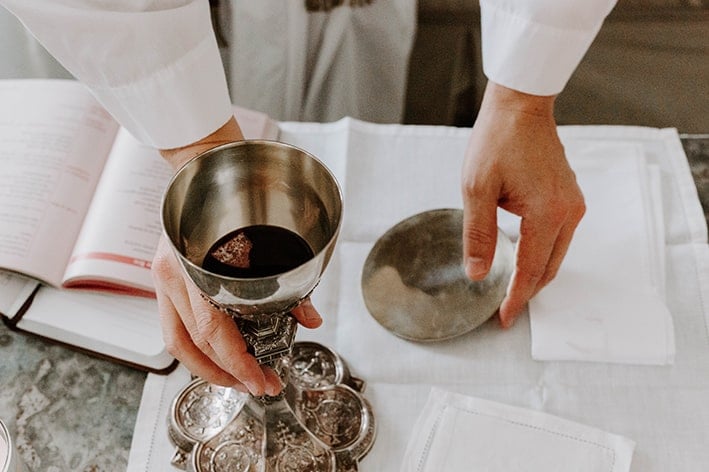
The reply to your question comes in the Catechism of the Catholic Church: “The Eucharistic presence of Christ begins at the moment of the consecration and endures as long as the Eucharistic species subsist. Christ is present whole and entire in each of the species and whole and entire in each of their parts, in such a way that the breaking of the bread does not divide Christ” (CCC 1377).
In saying “in each of their parts”, no mention is made of the size of the part. Every particle of the host and every drop of the Precious Blood, no matter how small, is equally Jesus Christ. We see this lived out in practice when the priest is distributing Communion and he sees that there are more people coming up than the number of hosts remaining in the ciborium. He can then divide the hosts as needed, giving each person a part of a host. Those who receive a part are receiving Jesus Christ whole and entire just as much as those who receive a whole host.
Your question, however, refers rather to the tiny fragments that may fall from the host at various moments. Concern not to lose any of these fragments goes back to the early centuries of the Church. St Cyril of Jerusalem, in his catechesis to new converts around the year 352, says: “With care, then, having sanctified your eyes through contact, receive the holy body, taking care that nothing be lost of it. For if you should lose something, you should consider it as if you had lost a part of your own body.
Because tell me: if someone gave you some gold filings, wouldn’t you safeguard them with every care, taking care not to lose any particle of them, nor to suffer any loss? Won’t you make an effort, then, with much more diligence, that not even one crumb fall of what is more precious than gold or precious stones?” (Cat. Myst. 5, 21)
For this reason, in the distribution of Communion it used to be common practice for the server to hold a Communion plate under the communicant’s chin or hand to catch any fragments that may fall. My own experience in this regard is that there are often tiny crumbs that fall onto the Communion plate, making its use both justified and recommended.
Every particle of the host and every drop of the Precious Blood, no matter how small, is equally Jesus Christ
The General Instruction of the Roman Missal (GIRM) instructs the priest: “Whenever a fragment of the host adheres to his fingers, especially after the fraction or the Communion of the faithful, the priest is to wipe his fingers over the paten or, if necessary, wash them. Likewise, he should also gather any fragments that may have fallen outside the paten” (n. 278). The paten, by the way, is the round, usually gilded, plate on which the large host is laid during Mass.
As a safeguard, a corporal, or square linen cloth, is placed on the altar and the sacred species are consecrated over this cloth to catch any crumbs of the host or drops of the Precious Blood that may fall on it outside the paten.
After Communion the GIRM also prescribes: “Upon returning to the altar, the priest collects any fragments that may remain. Then, standing at the altar or at the credence table, he purifies the paten or ciborium over the chalice, then purifies the chalice” (n. 162). The ciborium is the chalice-like vessel in which the small hosts are placed for Communion.
Often there are numerous particles of the hosts remaining in it, and these are swept with a finger into the chalice.
Also, after Communion the priest may scrape the corporal with the paten to collect any fragments of the host that may have fallen on it. He then wipes the fragments off the paten into the chalice. He also washes his fingers with water over the chalice to remove any particles adhering to them, and he then drinks the water, so that all the fragments are consumed.
As an added precaution, the corporal itself is usually washed separately from the other linens. It is customarily first rinsed in a bowl of water and then this water, which may contain particles of the host, is poured either into the sacrarium in the sacristy, which drains directly into the ground, or it is poured onto the ground under a tree or bush where no one can step on it. As you can see, great care is taken not to lose any of these tiny fragments.
Related:
